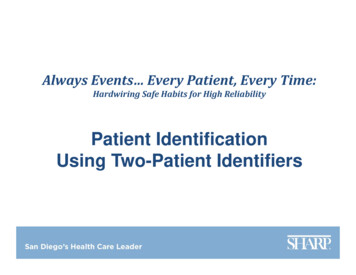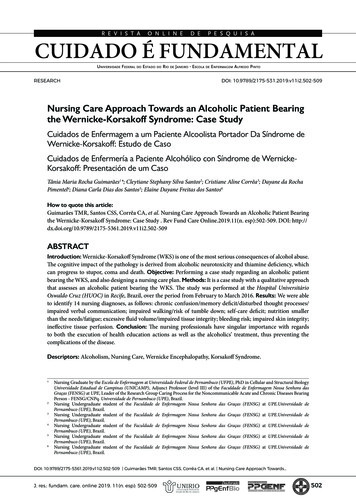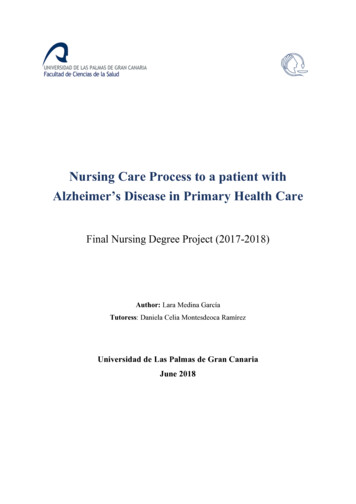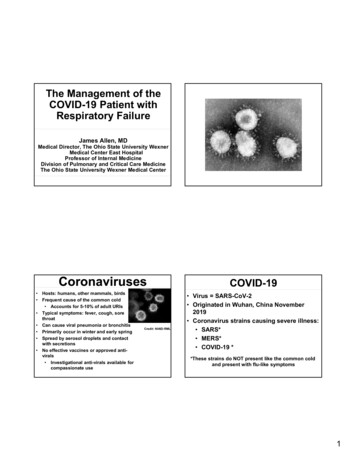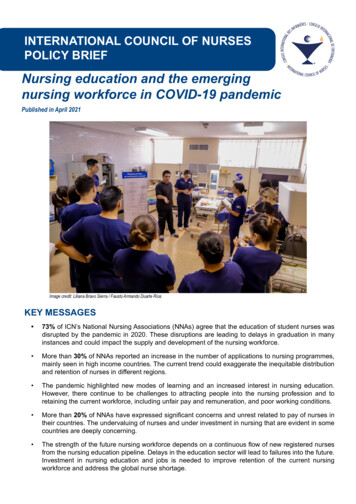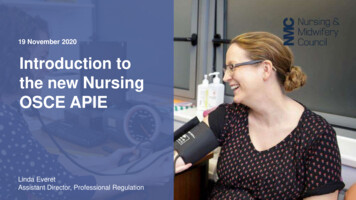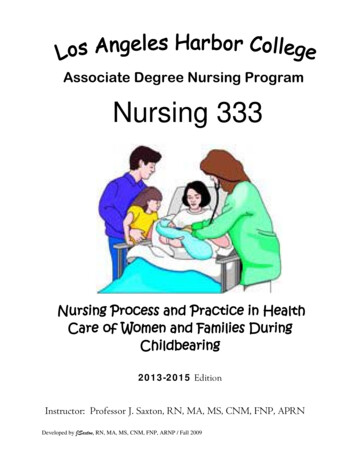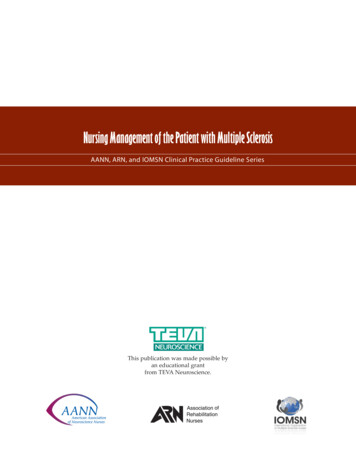
Transcription
Nursing Management of the Patient with Multiple SclerosisAANN, ARN, and IOMSN Clinical Practice Guideline SeriesThis publication was made possible byan educational grantfrom TEVA Neuroscience.
EditorsHilaire J. Thompson, PhD RN CNRN FAANKristen L. Mauk, PhD DNP RN CRRN GCNS-B, GNP-BCFAANAmerican Associationof Neuroscience NursesChairsAmy Perrin Ross, MSN APN MSCN CNRNSuzanne C. Smeltzer, EdD RN MSCN FAAN4700 W. Lake AvenueGlenview, IL 60025-1485888.557.2266, Fax 847.375.6430International phone 847.375.4733info@aann.org www.AANN.orgContent AuthorsJoan Kram, MBA RN FACHEExecutive DirectorMegan Barrett, DNP MSCN ARNPCheryl Blaschuk, MSN RN MSCN FNPKathleen Costello, MS ANP-BC MSCNConstance Easterling, MSN MSCN ARNPAnn Gutierrez, MSN RN CRRN CBISJune Halper, MSN APN-C MSCN FAANPaule Joseph, MSN FNP-BC RN CRRN BCLNC-CPatricia Kennedy, RN CNP MSCNMary Kitten, MSN RN MSCN CRRNMartha Lightfoot, ANPElizabeth McAndrews, MSN CRNPMargie O’Leary, MSN RN MSCNBrant J. Oliver, MSN MPH FNP-BC PMHNP-BCPatricia Pagnotta, MSN ARNP MSCN CNRNDorothea Cassidy Pfohl, BSN MSCN RNYaritza Rosario, APN MSCNAngela Stone Schmidt, PhD MNSc RNP RNMatthew Sorenson, PhD RNAlpa Uchil, MPH RNContent ReviewersLisa Duffy, PhD(c) CPNP-PC CNRNDebra A. Dzenko, MSN Ed RN-BC CCM CRRNJennifer Smrtka, ANP-BC MSCNJune M. Pinyo, MAManaging EditorSonya L. JonesSenior Graphic DesignerAssociation of Rehabilitation Nurses4700 W. Lake AvenueGlenview, IL 60025-1485800.229.7530info@rehabnurse.org www.rehabnurse.orgKaren Nason, CAEExecutive DirectorInternational Organization ofMultiple Sclerosis Nurses359 Main Street, Suite AHackensack, NJ 07601201.487.1050, Fax 201.678.2291www.iomsn.orgJune Halper, MSN APN-C MSCN FAANExecutive DirectorPublisher’s NoteThe authors, editors, and publisher of this document neither represent nor guarantee that the practices described hereinwill, if followed, ensure safe and effective patient care. The authors, editors, and publisher further assume no liability or responsibility in connection with any information or recommendations contained in this document. These recommendationsreflect the judgment from the American Association of Neuroscience Nurses, the Association of Rehabilitation Nurses, andthe International Organization of Multiple Sclerosis Nurses regarding the state of general knowledge and practice in ourfield as of the date of publication and are subject to change based on the availability of new scientific information.Copyright 2011 by the American Association of Neuroscience Nurses (AANN), the Association of Rehabilitation Nurses(ARN), and the International Organization of Multiple Sclerosis Nurses (IOMSN). No part of this publication may be reproduced, photocopied, or republished in any form, print or electronic, in whole or in part, without written permission ofAANN, ARN, or IOMSN.2Nursing Management of the Patient with Multiple Sclerosis
PrefaceIn 1997, the American Association of Neuroscience Nurses (AANN) created a series of patient care guidelines, the AANNReference Series for Clinical Practice, to meet its members’ needs for educational tools. To better reflect the nature of theguidelines and the organization’s commitment to developing each guideline based on current literature and evidence-basedpractice, the name of the series was changed in 2007 to the AANN Clinical Practice Guideline Series. This guideline represents a milestone in the series because AANN has now partnered with the Association of Rehabilitation Nurses (ARN)and the International Organization of Multiple Sclerosis Nurses (IOMSN) in the development of this guideline. This is thesecond guideline to be developed collaboratively between AANN and ARN and promotes evidence-based practice for theadult patient with multiple sclerosis (MS) across the continuum of care.Nursing care of patients with MS and their families or care partners has evolved from a focus on interventions duringperiods of crisis to a focus on symptom management, wellness, prevention of disease worsening, and empowerment. Thegoal of this guideline is to offer evidence-based recommendations on nursing activities that have the potential to maximizeoutcomes for adults with MS. Not all recommendations concern activities independently performed by registered nurses(RNs), but nurses are responsible for implementing and monitoring the outcomes of these activities. The evidence presented here may help nurses make appropriate choices when caring for patients with MS. Dependent on scope of practiceregulations, advanced practice nurses may have independent or collaborative responsibilities for activity performance;thus, this guideline may assist them in the management of patients with MS.Resources and recommendations must describe the best practices that can enable RNs to provide optimal care forpersons with MS. Accordingly, adherence to these guidelines is voluntary, and the ultimate determination regarding theirapplication must be made by practitioners in light of each patient’s individual circumstances. This reference is an essentialresource for nurses providing care to the adult patient with MS. It is not intended to replace formal learning but rather toaugment clinicians’ knowledge base and provide a readily accessible reference tool. The nursing profession, AANN, ARN,and IOMSN are indebted to the volunteers who have devoted their time and expertise to this valuable resource, which wascreated for those who are committed to excellence in the care of patients with MS.Nursing Management of the Patient with Multiple Sclerosis3
Table of ContentsI. Search Strategy and Levels of Evidence. 6A. Search strategy. 6B. Levels of evidence supporting the recommendations. 6II. Scope of the Problem: Definition, Natural History, and Epidemiology of Multiple Sclerosis (MS). 6A. Definition. 6B. Epidemiology. 6C. Types of MS. 6D. Natural history of the disease. 7E. Genetics. 7F. Environmental risk factors. 7G. MS symptoms. 8H. Effect of the diagnosis. 8III. Classification of MS. 9A. Introduction. 9B. RRMS. 9C. PPMS. 9D. SPMS.10E. PRMS.11F. Benign MS.11G. Malignant MS.11H. Other types.11I. Implications for patients.12IV. Immunogenetics and Pathogenesis. 12A. General background.12B. Pathophysiology of MS.12C. Blood-brain barrier (BBB) in MS.12D. T cell and B cell pathogenesis of MS.12E. Neurodegeneration in MS.13F. Remyelination.134Nursing Management of the Patient with Multiple Sclerosis
V. Assessment and Diagnostic Process. 13A. Introduction.13B. Diagnostic criteria for MS.14C. Assessment tools.14D. Assessment charts.16E. Assessment of reflexes.16F. Diagnostic testing.16G. Laboratory testing.20H. Diagnostic research studies: Biomarkers.22VI. Disease Management. 25A. Management of MS.25B. Economic considerations.26C. Immunotherapies reveal aspects of MS.26VII. Clinical Features and Symptom Management. 28A. Clinical features overview.28B. Sensory symptoms.29C. Visual and hearing impairment.31D. Fatigue.31E. Impaired mobility.33F. Bladder and bowel symptoms.34G. Sexual dysfunction and reproductive issues.35H. Dysphagia.
adult patient with multiple sclerosis (MS) across the continuum of care. Nursing care of patients with MS and their families or care partners has evolved from a focus on interventions during periods of crisis to a focus on symptom management, wellness, prevention of disease worsening, and empowerment. TheFile Size: 1MBPage Count: 49

